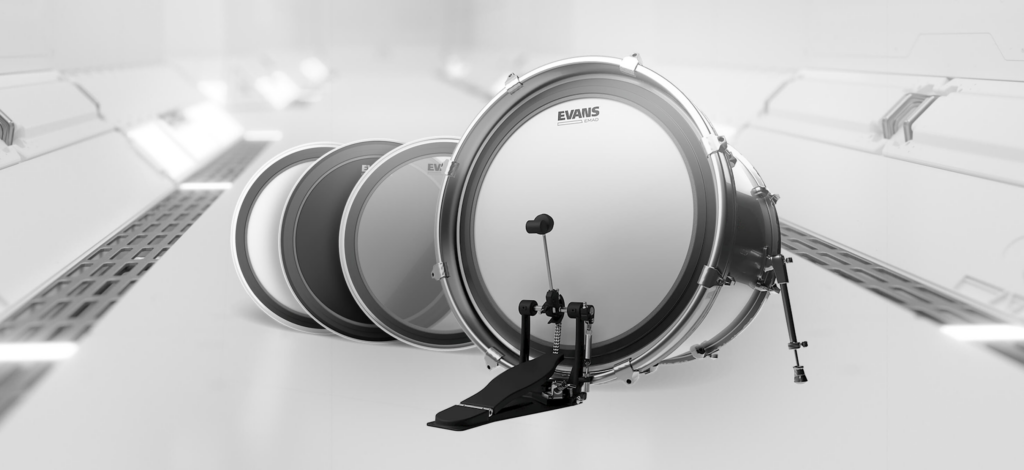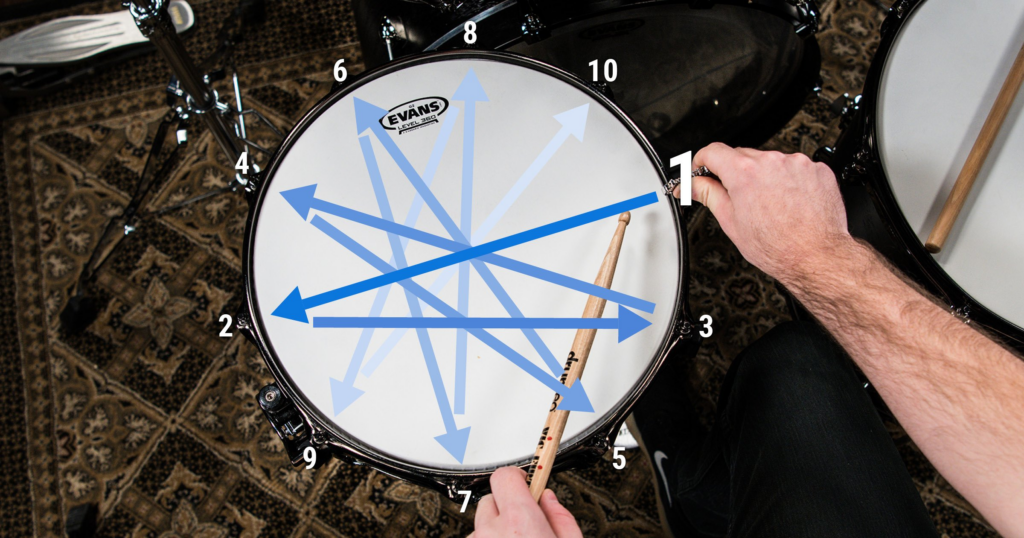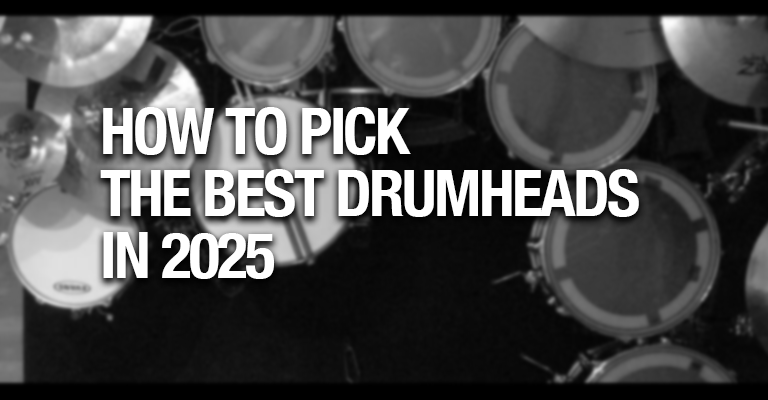To choose best drumheads in 2025 can really be intimidating with so many options. The right head can completely change your sound – more than your shells, sticks, or even cymbals.
Whether you’re chasing more punch, warmth, or control, this guide breaks down everything you need to know: single vs. double-ply, clear vs. coated, and which models work best for your style.
Drumheads shape your tone more than any other part of your kit. Start with a versatile model like the Remo Ambassador or Evans G2, then experiment based on genre and feel.
Before we break it all down about drumheads, I have made a table for quick decision making:
Recommendations: Best Drumheads
You’re probably ready to either upgrade your setup or start fresh with heads that actually match your sound. Here’s a quick guide to help you pick the best drumheads by category:
| Category | Recommended Model |
|---|---|
| Best Overall | Remo Ambassador Coated |
| Best for Rock | Aquarian Super-Kick III |
| Best for Metal | Evans Hydraulic |
| Best Budget Option | Aquarian Studio-X |
| Best Vintage Sound | Aquarian Deep Vintage II |
| Best Snare Head | Evans Genera HD |
| Best Bass Drum Head | Evans EMAD |
These picks represent years of field-tested performance, studio reliability, and player-approved tone.
Remember, there’s no one-size-fits-all solution. The perfect drumhead is the one that inspires you to play.
The Basics of Drumheads
Before we dive into coated vs. clear or which brand dominates the snare market, let’s take a second to define what a drumhead actually is and why it matters.

What Is a Drumhead?
A drumhead is the membrane stretched across the top (and most of the time bottom) of your drum shell. It’s what you actually hit and it’s what turns your drum into an instrument instead of a wooden cylinder.
There are two main types:
- Batter Head: The top head that you strike
- Resonant Head: The bottom head that helps control sustain, tone, and projection
Together, these two heads work like a speaker system, controlling how much sound your drum makes, how long it rings out, and how it reacts to different stick techniques.
Drumhead Materials
Most modern drumheads are made from Mylar, a durable plastic film that’s flexible enough to vibrate, but strong enough to take abuse. You’ll also find:
- Kevlar: Ultra-durable, used mostly for marching and high-tension snare heads
- Calfskin: Traditional and warm, but sensitive to humidity (used in classical or vintage jazz kits)
Some heads are made of a single layer of film, while others use two layers – which brings us to the next major factor…
Single-Ply vs. Double-Ply Drumheads
Single-Ply
- Made from one sheet of film
- Typically 10 mil thick
- More resonant, open, and lively
- Great for jazz, funk, or lighter rock
- Easier to tune high and project tone
Double-Ply
- Made from two sheets, often 7-10 mil each
- More controlled, durable, and focused
- Reduces overtones and sustain
- Preferred for rock, metal, and heavy hitters
If you’re playing light jazz gigs or want a more “singing” tom tone, single-ply might be your go-to. If you’re recording heavy breakdowns or you hit hard, double-ply is the safer call.
Clear vs. Coated Drumheads
The coating (or lack of) makes a surprisingly big difference:
Clear Heads
- Brighter, more attack-focused
- Longer sustain
- Great for rock, fusion, live settings
Coated Heads
- Slightly warmer and rounder in tone
- Shorter sustain
- Better for jazz, brushwork, studio work
Some drummers even mix them, for example: clear on the toms and coated on the snare – simply a technique used to get the best of both worlds.
Drumhead types
Now that you know the difference between ply, coating, and materials, let’s look at some of the most popular drumhead designs and why they exist.
Some are built for specific tones, others for control or durability, but knowing what’s out there helps you choose more precisely:
Hydraulic Drumheads
Hydraulic heads are two-ply heads with a thin layer of oil sandwiched between the layers. They were popularized in the 1970s and are still favored by rock and metal drummers who want a deep, focused sound with very little sustain.
- Sound: Warm, controlled, fat
- Feel: Slightly slower rebound, very dampened
- Best for: Rock, metal, loud venues
- Example: Evans Hydraulic Red or Blue
These are ideal if you’re battling ring or want your toms to sound like thunder without needing extra muffling.
Specialty Drumheads
Some heads are designed to solve specific problems – like excess overtones, weak low-end, or flappy bass drums. These are niche but powerful tools for tuning your sound exactly how you like it.
Evans EMAD (for bass drum)
- Interchangeable muffling rings
- Strong low-end punch
- Ideal for recording or modern rock kicks
Remo Powerstroke
- Built-in edge muffling
- Slightly drier sound with lots of focus
- Available for snare, toms, and kick
Aquarian Super-Kick
- Pre-muffled bass drum head
- Tight, fat sound right out of the box
- Great for live use or minimal tuning
These heads aren’t always beginner-friendly, but once you know what you’re after, they can be game changers, especially in the studio or on stage.
Choosing Drumheads for Your Needs
There’s no such thing as a one-size-fits-all drumhead. The best drumhead for your kit depends on what style you play, how hard you hit, and what kind of tone you want from each drum.

Probably most accurate and easiest way to understand your needs would be to break drumheads down used by genre and drum type so you can find the perfect fit.
By genres:
Rock
- You’ll want heads that can handle volume, feel punchy, and reduce unwanted ring.
- Go-to choices:
- Remo Emperor (double-ply for toms)
- Aquarian Super-Kick III (pre-dampened bass drum)
- Evans G2 Coated (great balance of durability and warmth)
Metal
- Look for control and durability. Most metal drummers use double-ply or even hydraulic heads to tame overtones and handle aggressive playing.
- Top picks:
- Evans Hydraulic
- Aquarian Force II
- Remo Pinstripe
Jazz
- Jazz drummers typically want open tone, warmth, and brush-friendly surfaces.
- Best options:
- Remo Ambassador Coated (especially on snare and toms)
- Evans G1 Coated
- Aquarian Modern Vintage
Funk / R&B / Gospel
- Focused tone with a quick attack works well here. Coated single-ply heads shine, often with some light dampening.
- Suggested heads:
- Remo Controlled Sound
- Evans EC2
- Aquarian Texture Coated Studio-X
By Drum Type:
Snare Drum
Your snare is all about articulation and attack. Most drummers use coated heads for extra warmth and stick definition.
- Popular choices:
- Evans Genera HD
- Remo Ambassador Coated
- Aquarian Hi-Energy
Toms
Tone and sustain are key here. Clear heads will give more punch and brightness, while coated heads warm up the sound.
- Recommended heads:
- Evans G2 Clear
- Remo Emperor Clear or Coated
- Aquarian Response 2
Bass Drum

You want depth, punch, and tight low-end. Most players go with specialty heads that have built-in dampening or use foam rings.
- Top bass drum heads:
- Evans EMAD
- Aquarian Super-Kick II
- Remo Powerstroke P3
Pro Tip: You can mix and match. Coated on the snare, clear on the toms, specialty head on the kick – make sure you find your own sound.
Best Drumhead Brands
While there are dozens of drumhead brands out there, three dominate the market for a good reason: they offer consistent quality, innovative designs, and heads for every style and budget.
Let’s take a look at Remo, Evans, and Aquarian, and what makes each one stand out.
Remo Drumheads

Remo is the OG of modern drumhead manufacturing. They’ve been around since the 1950s and are still the top choice for countless drummers across every genre.
Popular Remo Lines:
- Ambassador – Single-ply, warm, open tone. Industry standard for coated heads.
- Emperor – Double-ply, great for rock and louder styles.
- Pinstripe – Slightly muffled, short sustain, perfect for toms in live settings.
- Powerstroke – Built-in dampening ring for punchy, focused tone (popular on bass drums).
Remo is especially loved for its coated heads, which have a slightly textured feel that works great with brushes or soft dynamics.
Used by: Dave Grohl, John Bonham (historically), Taylor Hawkins, and many more.
Evans Drumheads

Evans is known for precision, innovation, and modern sound control. They were the first to create synthetic drumheads, and their current lineup includes smart features like Level 360 technology – making tuning easier and more consistent.
Popular Evans Lines:
- G1 / G2 – G1 is single-ply (bright & open), G2 is double-ply (durable & punchy).
- Hydraulic – Two-ply with oil inside for ultra-dampened tone.
- EMAD – Interchangeable muffling rings for bass drum customization.
- EC2 – Controlled tone for toms, with pre-EQ-style sound.
Evans heads are super popular with drummers who want plug-and-play tone with minimal fuss, especially in the studio or for metal/heavy rock.
Used by: Chris Adler, Travis Orbin, Matt Greiner, Benny Greb and many others.
Aquarian Drumheads

Aquarian may be the smaller name, but don’t sleep on them. They’re known for their durability, warm tone, and innovative features like the Vacuum Tuned system, which ensures even tension across the head.
Popular Aquarian Lines:
- Super-Kick – One of the most popular bass drumheads ever.
- Response 2 – Double-ply tom head, often compared to Remo Emperor.
- Hi-Energy – Super durable snare head with center dot.
- Modern Vintage – Calfskin-style coated head with a classic tone.
Aquarian is often favored by vintage lovers, gigging drummers, and anyone who likes a slightly warmer, less plasticky sound.
Used by: Eric Moore, Mike Johnston, Aaron Spears and many more.
Tune Drumheads for The Best Sound
Even the best drumheads won’t sound their best if they’re not tuned right. Tuning affects tone, sustain, attack, and feel. Knowing how to dial in both your batter and resonant heads can totally transform your kit.
Whether you’re setting up fresh heads or fixing a dull, flappy tom, here’s a reliable step-by-step tuning method that works across styles and setups.
Drumhead Tuning Guide
1. Seat the Head Properly

Place your drumhead on the shell evenly, followed by the hoop. Finger-tighten each tension rod in a star pattern. This makes sure there’s even pressure around the head.
Then, press gently in the center with your palm to “seat” the head and help it stretch evenly – this will help to stretch out the drumhead and make sure it holds the tuning later on.
2. Tighten in a Star Pattern

Using a drum key, tighten each lug a quarter turn at a time, always following a star pattern (like you would with car tires). This keeps tension balanced.
Start with a low tension and slowly bring it up. If you’re tuning a tom, you want both heads to be even or slightly different depending on your desired tone.
3. Tap Around the Head
Tap gently about 1 inch from each lug and listen. You want all tap points to sound as close in pitch as possible.
If one area is higher or lower, tweak it just a bit until everything’s balanced.
4. Tuning Batter vs. Resonant Heads
- Batter head (top): Controls attack and feel
- Resonant head (bottom): Affects sustain and tone
You can experiment with different tensions:
- Equal tuning: Balanced tone
- Batter tighter: More attack, quicker decay
- Resonant tighter: More sustain and deeper tone
5. Let It Settle
After tuning, play on the drum for a few minutes. Then re-check each lug. Heads stretch slightly, so you might need to fine-tune again.
In general, make sure you always tweak the drumheads while you play. Hitting drumheads may affect the rods and you will eventually lose the sound as you go, especially with cheaper drums!
Tuning Mistakes to Avoid
- Cranking the head unevenly (causes wrinkles and uneven tone)
- Ignoring the resonant head (half your tone lives here!)
- Overtightening to “fix” tone problems (it rarely works)
- Tuning toms too similarly (makes them blend instead of sing)
Maintenance and Replacement Tips
Even the best drumheads don’t last forever. Whether you’re gigging weekly or just practicing in your room, keeping your heads in good condition is key to maintaining tone and feel across your kit.
Here’s how to know when to replace them and how to make the most of each one while it’s still kicking.
Signs It’s Time to Replace Your Drumheads

If your kit’s starting to sound flat or inconsistent, check for these signs:
- Visible dents or pits (especially on snares and toms)
- Overstretched collar or wrinkles around the hoop
- Loss of sustain or clarity, even after tuning
- Coating worn off (especially if you use brushes or hit hard)
- Dead tone – if your tom sounds like cardboard, it’s probably time
Resonant heads wear out too – but more slowly. If they’re more than a year old and you’re having tone issues, they might be part of the problem.
Pro hack: If you have visible dents or pits – use a hot air blower to even out the surface – keep in mind, that this way you will stretch your drumhead and will need to do additional tuning. However, you will prolong the durability of drumheads for months.
How to Extend the Life of Your Drumheads
- Wipe them down after sessions (oil and sweat degrade coating)
- Tune evenly to prevent stress fractures
- Rotate sticks and heads occasionally to wear them evenly
- Store your kit properly – avoid extreme heat/humidity
- Use lighter sticks if you find you’re killing heads too fast (unless you’re in a death metal band, of course)
How Often to Replace Drumheads?
| Drum Type | Casual Use | Regular Gigging |
|---|---|---|
| Snare Batter | Every 3–6 months | Every 1–2 months |
| Tom Heads | Every 6–12 months | Every 3–6 months |
| Bass Drum | Every 6–12 months | As needed or by feel |
| Resonant Heads | Every 12–18 months | Every 6–12 months |
These are general guidelines and some players push their heads longer, but you’ll usually feel (and hear) the difference once they’ve gone stale.
If you are a really heavy hitter, make sure you divide those numbers by 10 atleast….
Some PROS do change heads almost every gig, so if your budget allows, change drumheads as frequently as possible.
Budget-Friendly Options vs. Premium Drumheads
Drumheads can range from $10 to $50+ per head, and if you’re outfitting a full kit, that adds up fast. But do you really need premium heads to sound good? Not always.
Here’s how to know when a budget head gets the job done, and when it’s worth investing in something higher-end.
Budget Drumheads Are Totally Fine
If you’re:
- Just starting out
- Practicing at home
- Playing on a low-volume kit
- Or you’re not super picky about tone yet
You’ll do just fine with entry-level heads, trust me. There is no need to invest heavily and break the bank.
Examples of decent budget options:
- Remo UX series (often found on beginner kits)
- Evans UNO or SoundOff heads (affordable + quiet)
- Aquarian Performance II (budget-friendly double-ply)
They may not last as long or sound as refined, but they’ll help you learn and keep your kit functional.
When to Go Premium?
If you’re:
- Recording or performing live
- A heavy hitter
- Tuning regularly and want tonal consistency
- Or you’re simply tired of lifeless-sounding toms…
Then it’s worth stepping up to premium heads like:
- Remo Ambassador / Emperor
- Evans G2 / EMAD / Genera
- Aquarian Super-Kick / Modern Vintage
Premium drumheads offer a noticeable upgrade in feel and performance. They respond more naturally under the stick, giving you better rebound and control, especially during dynamic playing.
The tone is clearer, fuller, and more consistent across different tunings – whether you’re going for a tight crack or a deep, resonant boom. They’re also built to last longer, meaning fewer dents, flakes, or sudden tone drop-offs.
And perhaps best of all, they make tuning easier and more predictable, saving you from the frustration of constantly chasing your sound.
Think of them like new tires for your car: the ride changes completely, and you notice it every time you sit down to play.
Pro Tip: If you’re on a budget, start with just your snare or kick drum. You’ll get the biggest tonal upgrade without replacing everything at once.
What are the best drumheads for beginners?
If you’re just starting out, go with a versatile, durable head that’s easy to tune. Single-ply coated heads like the Remo Ambassador Coated or Evans G1 Coated are great all-around options. They respond well to light and medium playing and work across many genres.
How often should I replace my drumheads?
That depends on how much and how hard you play:
Snare batter: Every 1–3 months for regular players
Toms: Every 6–12 months
Kick drum: When tone or rebound starts to fade
Resonant heads: Every 12–18 months, or sooner if recording
If you see dents, loss of tone, or flaking coating – then it’s time.
What’s the difference between batter and resonant heads?
Batter heads go on the top of the drum – you hit them.
Resonant heads go on the bottom – they shape the tone and sustain.
Think of the batter as the “feel” and attack, and the resonant as the “voice” and sustain.
Are coated or clear heads better for recording?
Coated heads are usually preferred in the studio, since they offer warmer tone, smoother stick response, and reduce unwanted overtones. That said, clear heads are great for brighter tones and attack, especially in pop or rock mixes.
Can I mix drumhead types on the same kit?
Absolutely. Many drummers run:
Coated on the snare for warmth
Clear on toms for punch
EMAD or Powerstroke on the kick for focused low-end
It all comes down to your personal sound goals.
Final Thoughts
Choosing the best drumheads doesn’t need to be a guessing game. Once you understand the basics – ply, coating, tuning, and brand nuances, you’ll have way more control over your kit’s sound than most drummers ever realize.
Try out different combinations. Mix clear and coated, single and double ply. Don’t be afraid to experiment until your kit feels like your voice.
And remember, your tone isn’t just in your sticks or technique – it starts with the heads you put on your drums.
✅ Want deeper breakdowns on drumsticks? Be sure to explore:



